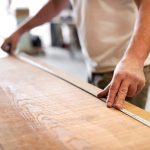The woodwork surrounding a front door plays a vital role in the overall aesthetic appeal and architectural design of a home. This article aims to explore and define the different components, materials, and styles associated with the woodwork around front doors. Understanding the significance and history of this element can help homeowners make informed decisions when it comes to enhancing their entrance.
In architectural design, the front door is often considered the focal point of a home’s facade. It sets the tone for the entire property, making a statement about the style and character within. The woodwork surrounding a front door acts as both a functional and decorative element, providing support and protection while adding warmth and visual interest to the entrance.
Historically, front door woodwork has evolved alongside changing architectural styles. From traditional paneling to elaborate carvings, different eras have seen distinct approaches to designing these intricate frames. By exploring these historical influences, homeowners can gain inspiration for their own projects and appreciate how craftsmanship has shaped our homes over time.
In the following sections, we will delve deeper into understanding the various components that make up front door woodwork, explore different architectural styles associated with it, examine common materials used in its construction, discuss customization options for creating unique designs, provide maintenance tips for preserving its beauty, highlight modern trends in front door woodwork design, and offer inspirational ideas for enhancing one’s entrance.
By delving into these topics, readers will gain valuable insights into harnessing the potential of their front door woodwork as a key element in transforming their home’s exterior.
Anatomy of a front door
The woodwork surrounding a front door is made up of several components that work together to create a cohesive and functional design. Understanding the different parts of this woodwork can help homeowners appreciate the craftsmanship involved and make informed decisions when it comes to maintenance and repair.
One of the main components of front door woodwork is the door frame. This is the structure that holds the door in place and provides stability. The frame consists of two vertical side jambs, a horizontal head jamb, and a sill at the bottom. It is typically made of solid wood or engineered wood products for durability.
Another important component is the door casing or trim. This is the decorative molding that frames the doorway and covers any gaps between the frame and wall. The casing adds visual interest to the entrance and can complement the architectural style of the home. Common styles include simple square profiles, more elaborate ornamental profiles, or streamlined modern profiles.
The third component is the door itself, which includes both functional and decorative elements. The core material of the door can vary depending on factors such as security needs, insulation requirements, and aesthetic preferences. Common materials for front doors include solid wood, fiberglass, steel, or a combination of these.
| Component | Description |
|---|---|
| Door Frame | The structure that holds the door in place; consists of side jambs, head jamb, and sill. |
| Door Casing/Trim | Decorative molding that frames the doorway; covers gaps between frame and wall. |
| Door | The actual entryway; can be made of different materials like wood, fiberglass, or steel. |
Understanding the anatomy of a front door woodwork allows homeowners to effectively communicate with professionals when it comes to repairs or renovations. It also enables them to make informed decisions about upgrading the various components for improved aesthetics and functionality. Whether you’re admiring the craftsmanship of your own front door or considering options for a new one, understanding these components helps foster a deeper appreciation for this important architectural feature.
Types of woodwork found around front doors
The woodwork surrounding a front door can vary greatly depending on the architectural style of the home. This section will explore some of the different types of woodwork commonly found around front doors, highlighting their unique characteristics and design elements.
Traditional Woodwork
In traditional architecture, woodwork around front doors often reflects the overall style of the home. For example, in a Victorian-style home, intricate detailing and ornate carvings may adorn the woodwork surrounding the entrance. These designs can range from delicate floral motifs to scrolling patterns reminiscent of the era.
In contrast, a Craftsman-style home may feature simpler and more streamlined woodwork. Clean lines and geometric shapes are typical in this style, with emphasis on showcasing the beauty of natural wood grain. Paneling and beveled edges are common features in Craftsman front door woodwork.
Modern Woodwork
Modern architecture has brought about a shift in front door woodwork design, often focusing on minimalist aesthetics and clean forms. Sleek and straight lines characterize modern woodwork, with an emphasis on simplicity and functionality.
Materials such as glass or metal are sometimes incorporated into modern front door woodwork to add a contemporary touch. For example, a front door might be framed by floor-to-ceiling windows or have sleek metal accents that complement the overall design.
Rustic Woodwork
In homes with a rustic or farmhouse style, front door woodwork typically exudes warmth and charm. The emphasis is often on showcasing natural elements and textures. Rustic front door wood trim may feature distressed finishes or rough-hewn logs for a weathered look.
Carved details depicting nature motifs such as leaves or animals are popular choices for rustic-inspired homes. Additionally, incorporating reclaimed or salvaged materials into the woodwork can add character to the overall design.
By understanding different architectural styles and their corresponding woodwork options, homeowners can choose front door woodwork that complements the overall design aesthetic of their homes. Whether it’s intricate detailing or minimalist simplicity, the woodwork surrounding a front door plays a crucial role in defining the character and style of a home’s entrance.
Common materials used in front door woodwork
The woodwork surrounding a front door is not only essential for the overall architectural design of a home, but it also serves as a functional and practical component. This section will delve into the common materials used in front door woodwork, highlighting the different types of wood that are commonly employed in this aspect of architectural design.
The Beauty and Versatility of Wood
Wood has been a popular choice for front door woodwork for centuries due to its natural beauty, durability, and versatility. It offers a warm and inviting aesthetic that can enhance the appearance of any home. Different types of wood possess varying characteristics and advantages, allowing homeowners to choose the right material that best suits their preferences and needs.
Popular Types of Wood for Front Door Woodwork
There is an array of woods available for front door woodwork, each with its own unique qualities. Some commonly used woods include:
- Mahogany: Known for its rich color and fine grain pattern, mahogany is a popular choice for its elegance and resistance to rotting.
- Oak: Oak is a durable hardwood known for its strength and longevity. It is often favored for its distinct grain patterns and ability to resist insect damage.
- Walnut: Walnut wood offers a dark brown color with beautiful patterns. It is highly valued for its beauty and workability.
- Teak: Teak wood is highly resistant to decay, making it suitable for exterior applications. Its natural oils provide protection against water damage.
Each type of wood brings its own unique characteristics to the front door woodwork, allowing homeowners to achieve their desired aesthetic while ensuring durability and longevity.
Considerations when Choosing Wood for Front Door Woodwork
When selecting the right type of wood for front door woodwork, there are several factors to consider. First, it’s important to understand the climate in which the door will be exposed to ensure that the chosen wood can withstand the environmental conditions. Additionally, the desired maintenance level should be taken into account. Some woods require more frequent maintenance, such as staining or sealing, to preserve their natural beauty and protect them from weathering.
Customization and decorative elements
When it comes to the woodwork surrounding a front door, there are numerous ways to add decorative elements and customize the design to suit your personal style. These customization options not only enhance the aesthetic appeal of the entrance but also provide an opportunity to showcase your individuality. Here are some popular decorative elements that can be incorporated into the woodwork surrounding a front door:
- Carvings: Intricate carvings in the woodwork can create a stunning visual impact and add a touch of elegance to your front entrance. From intricate floral patterns to geometric motifs, carvings allow you to create a unique and personalized design that reflects your taste.
- Paneling: Paneling is another way to enhance the woodwork surrounding a front door. This involves adding wooden panels, either vertically or horizontally, which can have various designs like raised or recessed panels or even beveled edges. Paneling adds depth and texture to the entrance while maintaining a traditional charm.
- Moldings: Incorporating moldings into the woodwork can bring about a sense of sophistication and intricacy. Moldings can be applied around the perimeter of the doorframe or used as decorative accents on other components such as window sills or pediments.
By combining these customization options, homeowners have the opportunity to transform their front door’s woodwork into an exquisite work of art that makes a bold statement about their personal style and enhances the overall curb appeal of their home.
In addition to customizing the design, it is essential to choose suitable materials for these decorative elements. Opting for high-quality hardwoods such as mahogany, oak, or walnut ensures durability and longevity while adding richness and warmth to the woodwork. However, if budget constraints are a concern, there are also alternative materials available that mimic wood’s appearance without compromising on quality.
Whether you prefer a classic or contemporary look, there is no shortage of possibilities when it comes to customizing and adding decorative elements to the woodwork surrounding your front door. With careful consideration of design elements and materials, you can create a one-of-a-kind entrance that welcomes guests and elevates the overall aesthetic appeal of your home.
Maintaining and preserving front door woodwork
One of the most important steps in maintaining front door woodwork is regular cleaning. Dust, dirt, and grime can accumulate on the surface of the wood, diminishing its natural beauty. It is recommended to clean the woodwork at least twice a year using a mild soap or detergent mixed with water.
Gently scrubbing the wood with a soft-bristled brush will help remove any stubborn stains or debris. After cleaning, thoroughly rinse off the soap residue with clean water and allow the wood to dry completely before applying any protective coatings.
In addition to regular cleaning, it is crucial to protect front door woodwork from moisture and sunlight. Moisture can lead to rotting or warping of the wood, while prolonged exposure to sunlight can cause fading and discoloration. To prevent these issues, it is advisable to apply a high-quality sealant or finish specifically designed for exterior wood surfaces.
This protective layer acts as a barrier against moisture and UV rays, ensuring that the wood remains strong and vibrant over time. Reapplying the sealant every few years or as needed will help maintain its effectiveness.
To further enhance the durability of front door woodwork, homeowners should inspect it regularly for any signs of damage or wear. Small cracks or splits in the wood should be addressed promptly by filling them with an appropriate filler material and sanding down until smooth.
If more severe damage is present, such as extensive rotting or decay, it may be necessary to replace certain sections of the woodwork entirely. Consulting with a professional woodworker or carpenter can provide expert advice and assistance in addressing such issues.
By following these maintenance practices and ensuring proper care, homeowners can preserve the beauty and functionality of their front door woodwork for many years. The investment of time and effort is well worth it, as a well-maintained front door woodwork not only enhances the aesthetic appeal of a home but also contributes to its overall value.
Modern trends in front door woodwork
Front door woodwork has seen significant evolution over the years, with modern trends influencing its design and functionality. In today’s contemporary architecture, front door woodwork plays an important role in enhancing the overall aesthetic appeal of a home. Architects and homeowners alike have embraced new materials, innovative designs, and technology-driven features to create stylish and functional entrances.
One notable trend in modern front door woodwork is the use of sleek and minimalist designs. Clean lines, geometric shapes, and smooth finishes are highly sought after in contemporary homes. This style often favors the use of materials such as glass, metal accents, and composite woods to achieve a sleek and sophisticated look. The emphasis is on simplicity and creating a seamless transition between the exterior and interior spaces.
Another emerging trend is the incorporation of smart features into front door woodwork. With the rise of smart homes, homeowners are increasingly looking for entryways that are not only visually appealing but also technologically advanced. This includes integrating keyless entry systems, biometric authentication methods, and even video surveillance into the design of the front door woodwork.
Additionally, sustainability has become a significant concern in modern front door woodwork. Many architects and homeowners are opting for eco-friendly materials such as reclaimed wood or sustainably sourced hardwoods. These materials not only contribute to reducing environmental impact but also bring warmth and natural beauty to the entrance.
Inspirational ideas for enhancing front door woodwork
The woodwork surrounding a front door is not only functional but also serves as an important aesthetic element in architectural design. It can greatly enhance the overall look and feel of a home’s entrance. In this section, we will explore some inspirational ideas for enhancing front door woodwork, showcasing stunning designs from around the world and offering suggestions for homeowners who want to make their entrance more unique.
One way to enhance front door woodwork is through the use of intricate carvings. This technique adds a touch of elegance and sophistication to the design. Carved woodwork can feature various patterns, motifs, or even personalized symbols or emblems that hold special meaning to the homeowner. These intricate details can create a focal point and make a strong visual statement.
Another way to enhance front door woodwork is through the use of paneling. Paneling involves adding decorative panels made from wood or other materials to the surface of the door or its surrounding frame. This technique allows for added texture and dimension to be introduced into the design. Paneling can be done in a variety of styles, such as raised panels, recessed panels, or even geometric patterns.
Moldings are another popular element in enhancing front door woodwork. Moldings refer to decorative trim that is applied around the edges or frames of doors and windows. They add a finishing touch and provide architectural interest by accentuating the lines and contours of the woodwork. Moldings come in various shapes and sizes, including crown moldings, baseboards, and casings.
Incorporating these inspirational ideas into front door woodwork can transform an ordinary entrance into a show-stopping feature that enhances the overall curb appeal of a home. Whether it’s through intricate carvings, paneling, or moldings, each design choice offers its own unique charm and flair.
| Idea | Description |
|---|---|
| Intricate Carvings | Adds elegance and sophistication to the design. Allows for personalized symbols or emblems. |
| Paneling | Adding decorative panels to the surface of the door or its surrounding frame. Adds texture and dimension. |
| Moldings | Decorative trim applied around the edges or frames of doors and windows. Adds architectural interest. |
Conclusion
In conclusion, the woodwork surrounding a front door is a significant element in architectural design and adds character and charm to any home. Throughout this article, we have explored the various components, types, materials, customization options, maintenance tips, modern trends, and inspirational ideas associated with front door woodwork.
The woodwork around a front door has a rich historical background that has evolved over time. From simple functional structures to intricate and ornate designs, front door woodwork reflects the architectural style of different periods. Understanding the anatomy of a front door and its various components allows homeowners to appreciate the craftsmanship that goes into creating a beautiful entrance.
When it comes to materials used in front door woodwork, there are numerous options available. Different wood species offer unique characteristics in terms of durability, aesthetics, and maintenance requirements. The choice of material depends on individual preferences and specific needs.
Customization is another critical aspect of front door woodwork. Homeowners can incorporate decorative elements such as carvings, paneling, moldings, or other design features to personalize their entrances. Additionally, regular maintenance is essential for preserving the beauty and functionality of front door woodwork.
In contemporary architecture, there is an increasing emphasis on using front door woodwork as an expression of creativity and style. Modern trends highlight sleek and minimalist designs while still maintaining the elegance and class traditionally associated with front doors.
As we conclude this article today on appreciating the woodwork surrounding a front door, we encourage readers to consider their own front doors as an essential element in their home’s overall design. The woodwork around your front door not only enhances curb appeal but also creates a warm and inviting atmosphere for you and your guests.
Whether you choose a classic or contemporary style or add unique customizations, remember that the woodwork surrounding your front door is an opportunity to make a statement about your personal aesthetic tastes. Embrace this valuable aspect of your home’s design and let it reflect your own unique personality and style.
Frequently Asked Questions
What is the trim around a front door called?
The trim around a front door is typically referred to as door casing or door trim. It is the decorative molding that frames and enhances the appearance of the entrance door.
Door trim can vary in design and style, ranging from simple and understated to ornate and intricate. It serves to provide a finished look, cover any gaps between the wall and the door frame, and can also protect the edges of the wall from potential damage.
What do you call the thing between door and frame?
The thing between a door and its frame is commonly known as a door jamb or door frame. It is typically made of wood and consists of two vertical side jambs, which act as a support for the door, as well as a horizontal top jamb that connects them at the top.
The purpose of the door jamb is to provide stability and structure to the doorway while creating a sealed area for the door to close against. It helps maintain proper alignment, prevents drafts, and enhances security by providing a solid anchor point for locks.
What is the timber that goes around a door?
The timber that goes around a door is often referred to as either door casing or architrave. Architrave is specifically used in architectural terminology to describe decorative moldings that surround windows, doors, or other openings in walls. These timber casings or architraves are installed around doors for both functional and aesthetic reasons.
They serve as a decorative element that adds character and style to doors while also concealing any gaps between the wall surface and edges of the doorframe. In addition, they protect vulnerable areas from wear and tear over time by acting as a barrier against potential damage caused by regular use or accidental impacts.

Hi everyone! I’m a woodworker and blogger, and this is my woodworking blog. In my blog, I share tips and tricks for woodworkers of all skill levels, as well as project ideas that you can try yourself.





